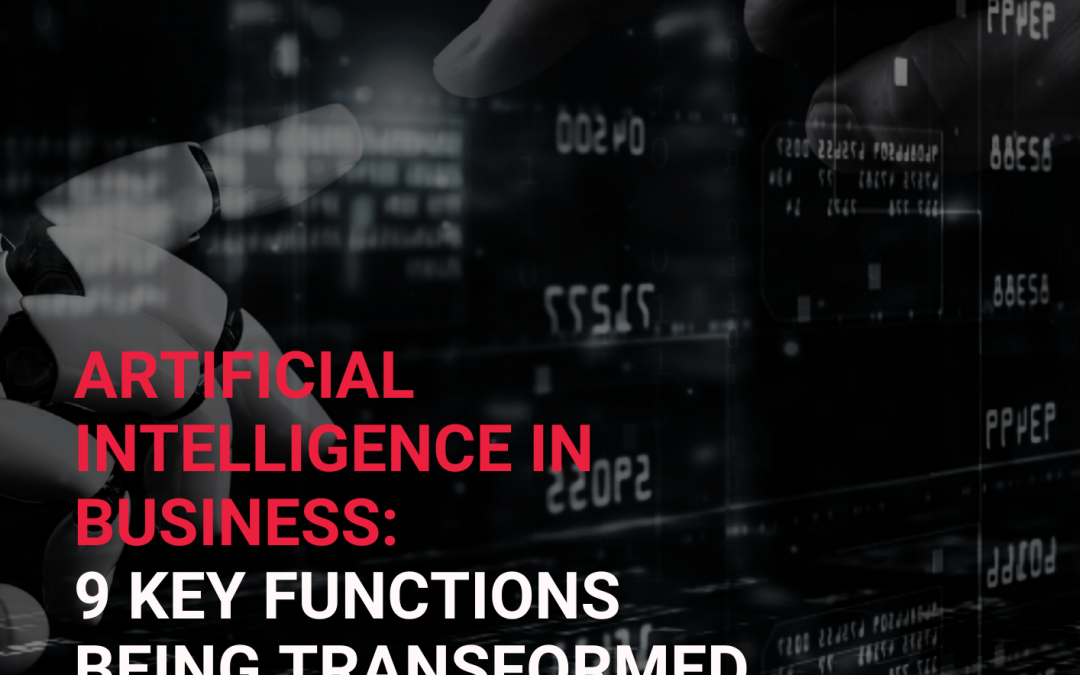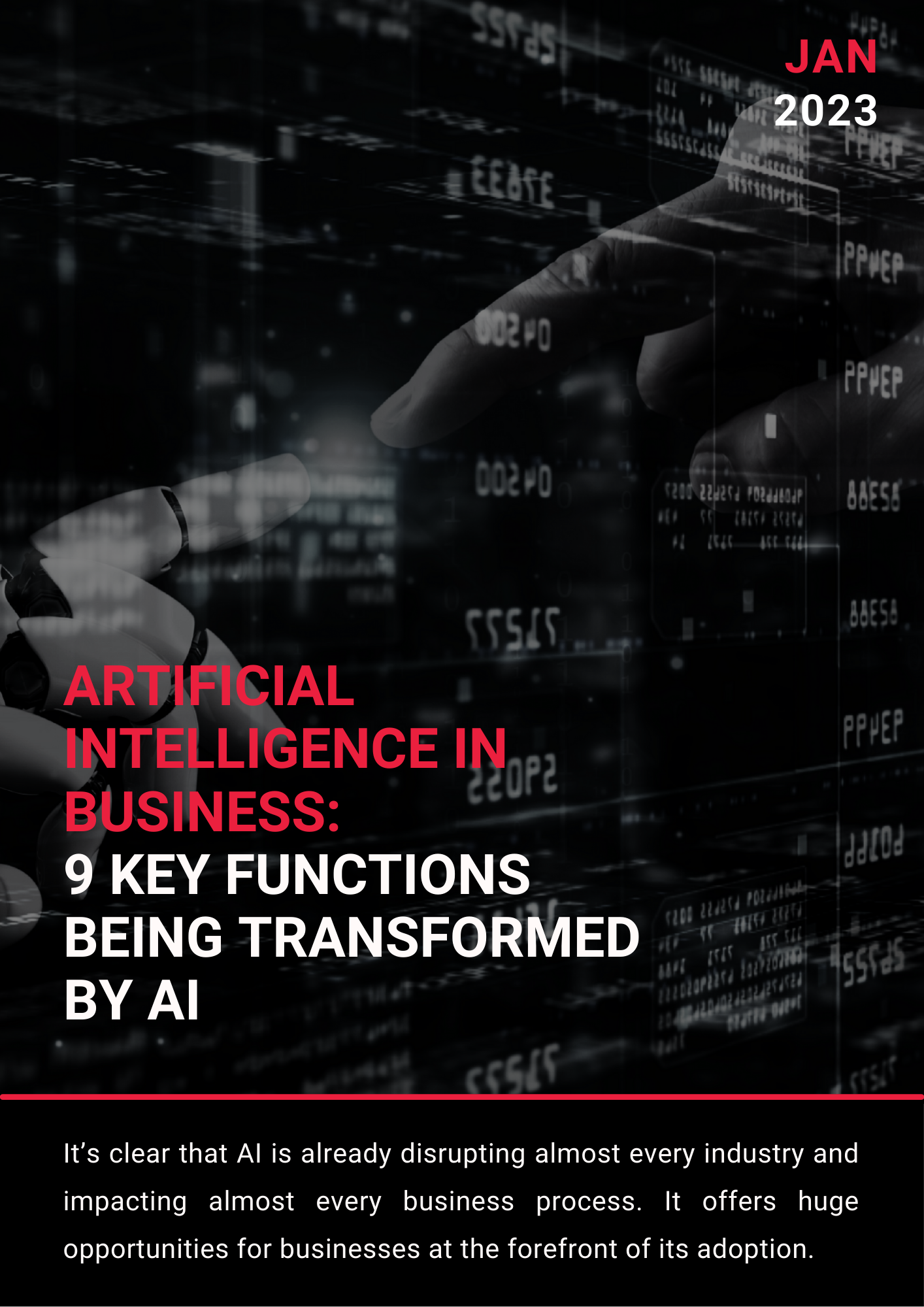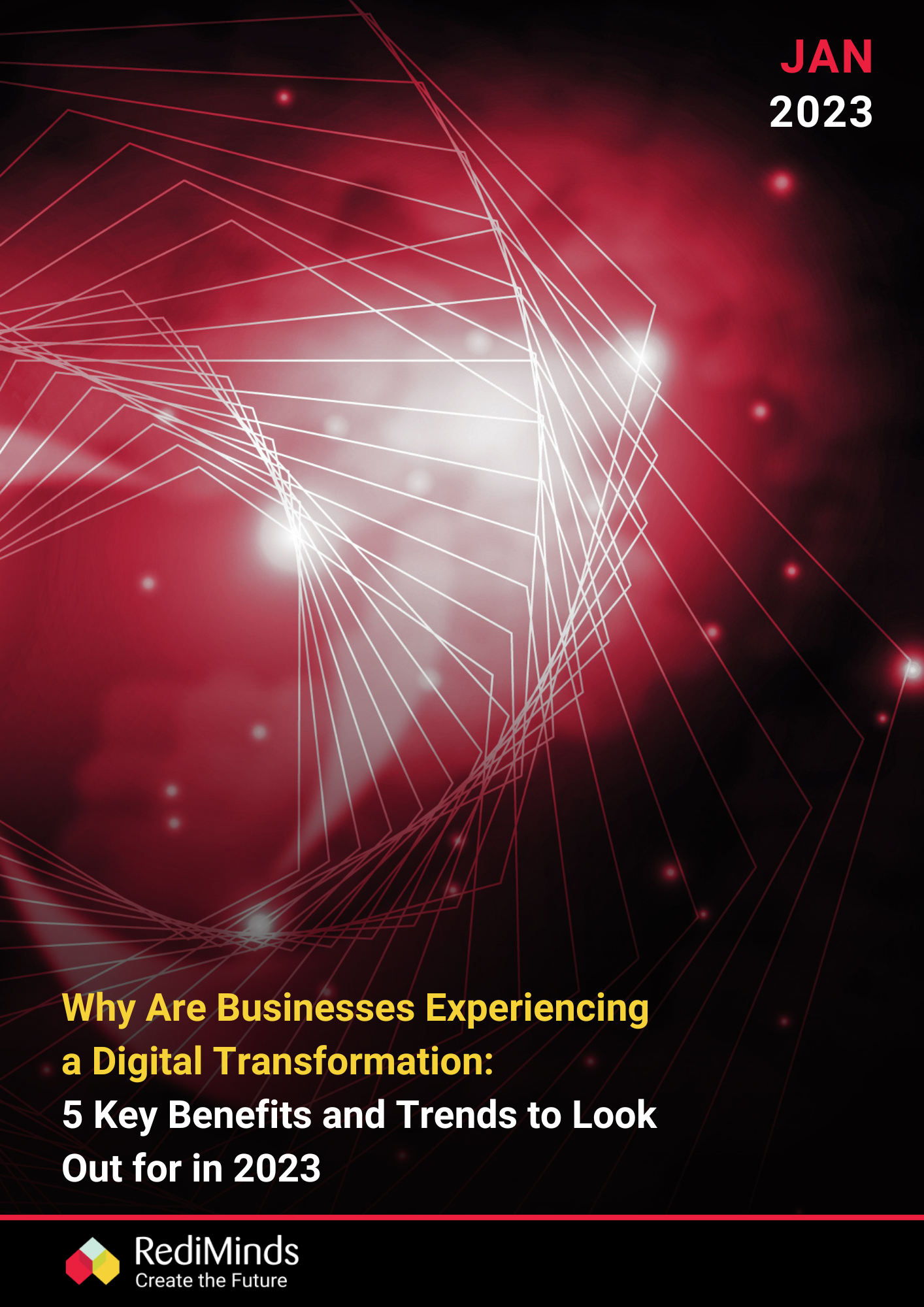
9 Business Functions Being Transformed by Artificial Intelligence

Artificial Intelligence in Business: 9 Key Functions Being Transformed by AI
The guide to AI technologies that are revolutionizing how we do business, disrupting every industry and impacting almost every business process.
By submitting your details, you are subscribing to our marketing communications. You can unsubscribe at any time.
Content Topics:
What is Artificial Intelligence
The Rise of Artificial Intelligence in Business
9 Examples of AI Transforming Business Functions
AI trends to look out for in 2023 and beyond
Artificial Intelligence: Choosing the Right Partner
Don’t have time to read it all right now? Download the entire guide to save it for later or share it with your team.
Artificial Intelligence (AI) has become commonplace in all our lives. In fact, 77% of the devices we use feature a form of AI.
It’s clear that AI is already disrupting almost every industry and impacting almost every business process. It offers huge opportunities for businesses at the forefront of its adoption.
Let’s explore exactly what AI means for businesses and the future trends to watch in this constantly evolving field:
- What is Artificial Intelligence
- The Rise of Artificial Intelligence in Business
- 8 Examples of AI Transforming Business Functions
- AI trends to look out for in 2022 and beyond
- Artificial Intelligence – Choosing The Right Partner
What is Artificial Intelligence?
Artificial intelligence is the programming of machines to replicate decision-making that typically requires human intelligence.
The field of AI covers technologies from machine learning and deep learning to computer vision and natural language processing.
Machine Learning
Machine learning is the most widely recognized and understood branch of AI. ML algorithms improve over time to more accurately predict outcomes. For example, Netflix’s recommendations system improves the more shows we watch.
Deep Learning
Deep learning is a type of machine learning that involves training artificial neural networks to perform specific tasks. Tasks include image recognition, natural language processing, and decision-making.
The ‘deep’ in deep learning refers to the neural networks being equipped with many layers, allowing them to learn complex and abstract representations of data.
The specialty of neural networks is that they are designed to mimic the way humans think.
The most common example of deep learning is self-driving cars. The models analyze multiple forms of inputs and make decisions in real-time intended to mirror how a human would react in the same situation.
AI technologies like this, coupled with the right data, analytics, and automation, can expand the capabilities of businesses immensely and help them achieve their strategic goals in ways previously unimaginable.
Types of Artificial Intelligence
AI as we know it today is ‘weak’ or ‘narrow’ AI – designed to perform only a specific task or a group of closely related tasks like Apple’s Siri or personalized social media ads.
These systems are powerful and have a huge impact on how we live and work, but their specialized applications still only have a limited scope.
The AI we often see in sci-fi movies – robots that can outperform humans at any task (think Vision from the Avengers movies) – is ‘strong’ or ‘general’ AI. For the time being this type of AI remains fictional, but is the ultimate goal for many researchers. If achieved, it could see technology quickly outsmarting humans.
“As AI gets probably much smarter than humans, the relative intelligence ratio is probably similar to that between a person and a cat” – Elon Musk
But with no real-life examples of strong AI yet, today’s narrow AI remains an enhancement of our human capabilities rather than a replacement.
The Rise of Artificial Intelligence in Business
AI was first named in 1956 by John McCarthy. so it has taken some time to reach this critical point for businesses across industries.
75% of executives now fear going out of business within five years if they don’t focus on scaling AI.
With advances in cloud computing and processing power, businesses have access to data like never before. This has thrown the doors wide open for AI technologies that harness the power of that data.
This also opens up the possibility for business leaders to combine digital transformation with AI. This transformation enhances current capabilities and creates completely new capabilities. Companies at the forefront of this are already having an impact on our lives every single day.
3 Examples of AI in Business You Must Know
Amazon
Have you ever wondered how Amazon manages to deliver products to you on the exact same day, often in a matter of hours?
Amazon began its AI evolution by developing its website recommendations engine but soon took it much further. Their entire distribution network now essentially runs on AI.
This means they can recommend products to their customers and use predictive models to shift stock between their warehouses in advance of purchases – all through the power of AI.
Amazon are even making strides with machine learning and natural language processing in healthcare with their Comprehend Medical System.
Tesla
When it comes to companies having success with AI, Tesla of course deserves a mention.
Their self-driving car technology is set to revolutionize safety and comfort on our roads. Not to mention the Tesla Bot, an autonomous humanoid robot, designed to take over all the boring tasks that we humans simply don’t want to do.
Uber
The world’s largest taxi firm takes no chances when it comes to cutting-edge technology – and it has paid off, with 93 million people using the app every month.
They’re using computer vision to more accurately confirm the identity of drivers and improve safety. Machine learning is forecasting demand and ETAs. Not to mention that they also have their own skin in the game when it comes to self-driving vehicles.
Benefits of AI in business
The largest appeal of AI cited by business leaders is the power to automate mundane and repetitive tasks. This allows employees to focus on valuable, strategic tasks that need human input – boosting efficiency and productivity.
Investing in AI can also significantly reduce operational costs in the long run as AI operates at a pace and scale humans can’t.
A further consequence is a reduced margin for error and higher accuracy with less human intervention.
In essence, these benefits serve one overarching purpose – to maintain or improve a company’s competitiveness. AI technologies drive efficiency, accuracy, and the availability of information. The result is more informed decision-making that enhances competitive advantage.
Challenges of AI in business
A large challenge faced by businesses implementing AI into their strategy is data scarcity. The amount of data out there is difficult to comprehend. But it can be difficult for companies to actually get their hands on enough of that data.
For machine learning to work effectively, it requires a large amount of data to train a model to be successful. Generally speaking, the more data the better the results. This raises the question of how a company can best access, store, and process this data to train the models.
Another example is businesses in newly emerging fields – there simply won’t be enough data in existence to harness the full effects of AI yet.
What it means for the workforce
No business survives without the efforts of its employees. So, what does AI implementation mean for them?
Successful implementation of AI doesn’t end with executing the software. User adoption is critical.
Even the most digitally forward companies need a cultural shift as processes and ways of working inevitably change.
That’s why it’s essential that teams understand how important these new technologies are to the success of the business and the benefits to themselves. AI is an augmentation of their capabilities, not a replacement for them.
9 Examples of AI Transforming Business Functions
If your company isn’t using AI-enhanced technologies in some capacity, you’re already behind the curve.
Here are the 8 areas you should consider to focus your AI efforts:
- Customer Service
- Marketing
- Sales
- Accounting & Finance
- Research & Development
- IT Operations
- Human Resources
- Supply Chain & Manufacturing
- Cybersecurity
1. Customer Service
Business is about serving your customers well. So it’s no surprise that customer service is one of the key functions where leaders are adopting AI.
For example, chatbots are offering customers access to 24/7 support. As the fastest-growing method of communicating with customers in 2020, 24.9% of customers used chatbots to communicate with brands.
Aside from communication, businesses are using AI to analyze customer behavior. The results are driving improvements in customer service and the actual products or services they offer.
2. Marketing
Marketers at the forefront of adopting AI tools are using advanced technologies and insights to enhance their marketing efforts. For example, optimizing campaigns through targeted ads on social media and search engines that use metrics like customer browser history to improve targeting.
Marketing teams should also be adopting tools that track marketing insights. AI-driven metrics like click-through and conversion rates help optimize campaigns and assist with customer segmentation.
3. Sales
Arguably sales will remain a human-lead function, especially for high-ticket products and services. Yet, AI technologies can augment the capabilities of sales teams. They provide more accurate sales forecasts, key performance indicator (KPI) tracking, and automated customer follow-up reminders.
4. Accounting & Finance
Finance professionals are reaping the benefits of AI technology to shift their focus from repetitive data entry tasks to strategic, value-adding activities.
This automation reduces errors and considerably frees up their time.
But it also allows for monitoring real-time financial status – something not possible without AI.
5. R&D
Taking advantage of AI for R&D opens doors to analyzing massive amounts of data much more accurately and efficiently.
Deep learning and machine learning can also solve hugely complex problems that we as humans couldn’t overcome.
In turn, this drives more informed decision-making and strategic research.
The result? New opportunities and revenue streams whilst also reducing operating costs.
6. IT Operations
Implementing AI technologies and automation can completely transform IT ops. Often, companies use outdated and inefficient systems that have a huge negative impact on productivity.
How often do you experience IT issues at work?
AIOps (AI for IT operations) leverages the power of AI to manage systems. It’s possible to automate routine maintenance, proactively troubleshoot, and manage system updates.
Adopting these technologies ultimately boosts efficiency, cost-effectiveness, and also cybersecurity.
7. Human Resources
AI automates repetitive, data-driven HR tasks so that professionals can focus on the ‘human’ side of HR – the tasks that add more real value to the function. For example, 24/7 chatbots to respond to common HR queries and improved analytics to track HR KPIs.
Improving the experience of candidates during recruitment, enhancing employee training, and providing greater insights – AI is certainly strengthening the toolkit of HR professionals.
8. Supply Chains & Manufacturing
Supply chains have become substantially harder to manage – most notably due to the effects of the COVID-19 pandemic. Resilience and sustainability are more crucial than ever before to navigating challenges.
AI is changing the face of processes from procurement and logistics to manufacturing and warehousing. AI-driven supply chains can improve demand forecasting and materials shortage predictions, and even assist in quality control using computer vision.
This improved monitoring and visibility across the whole supply chain are driving strategic decisions.
9. Cybersecurity
It’s clear that AI is having a significant impact on all business functions and security is no exception to this. Not only does the additional data capture and storage required to use AI technology impact the level of security companies need to protect that data, but AI is augmenting those security capabilities as well.
Machine learning models can be trained to identify security risks in real-time. This ability can be utilized by banks to alert to any abnormal consumer spending, and by enterprises to automatically detect malware and keep track of IT asset inventory.
AI is also being harnessed to automate a lot of mundane tasks, freeing up the time of IT teams for more pressing matters that require their manual intervention.
Check out our full article on artificial intelligence in cybersecurity.
AI Trends to Look Out for in 2023 and Beyond
AI has the potential to increase productivity by up to 40% by 2035.
In the aftermath of the COVID-19 pandemic, it’s clear that digital-first companies are coming out on top in most cases. Now more than ever, companies are expected to double down on their AI-first approach.
50% of employers reported planning to accelerate automation in response to COVID-19.
That number is only set to grow, with a massive 81% of employers expecting to have adopted AI into their businesses by 2025.
- Accelerate the digitalization of work processes (e.g. use of digital tools, video conferencing) 84%
- Provide more opportunities yo work remotely 83%
- Accurate automation tasks 50%
- Accelerate the digitalization of upskilling/reskilling (e.g. education technology providers) 42%
- Accelerate the digitalization of upskilling/reskilling programmes 35%
- Accelerate ongoing organizational transformations (e.g. manufacturing) 34%
- Temporarily reassign workers yo different tasks 30%
- Temporarily reduce worforce 28%
- Permanently reduce worforce 13%
- Temporarily increase worforce 5%
- No specific measures implemented 4%
- Permanently increase worforce 1%
Planned business adaptation in response to COVID-19 – Future of Jobs Survey 2020, WEF
With technologies constantly advancing, what are some of the key emerging trends to look out for?
Chatbots
Already rising in popularity with both businesses and consumers, chatbots are set to continue on their trajectory of growth with further advancements in natural language processing (NLP). By 2024 consumer retail spend via chatbots is expected to reach $142 billion—up from just $2.8 billion in 2019.
ChatGPT
Openai released their ChatGPT service in November 2022 and it has taken the world by storm.
Achieving 1 million users in just 5 days there’s no questioning the ability of the application.
To put that into perspective, it took Instagram 2.5 months to reach 1 million users.
The application is simple: You ask it a question and it presents you with an answer.
ChatGPT and other language models like it have the potential to greatly impact businesses in the future by automating customer service and support tasks, such as answering frequently asked questions and providing information about products and services. They can also be used for tasks such as content generation and data analysis.
Additionally, language models can be integrated into virtual assistants and chatbots, which can improve customer engagement and experiences.
Overall, the use of language models in businesses can help to increase efficiency and reduce costs while also improving the overall customer experience.
Now, what if we told you that the last three paragraphs were written entirely with ChatGPT?
It didn’t produce the most riveting read, but you can see how the application definitely has merits that can be used to aid businesses now, and even more so in the future as it develops further.
The application is also currently being used to help people write code, generate ideas, and summarize lengthy pieces of information.
Here, we asked the application to “write me a piece of javascript code for a simple game. The game is a block character that has to jump over obstacles” – And this response took less than 60 seconds.

AI image generation
Similar to ChatGPT, Openai released an AI image generation tool – Dall-E.
The concept is similar. Users input something they want the tool to design and it generates an image.
For example, we asked it to generate an “image of a dog sitting on a chair in the style of Vincent van Gogh” and it produced these results within 60 seconds:

On the face of it, this seems a little “gimmicky”. However, the potential for businesses to adopt this into their workflows creates a huge potential to improve productivity.
E-commerce companies can use AI-generated images as product images, advertising agencies can use AI-generated images and videos for advertisements, and designers can use it for assistance in their design process.
And that’s just the tip of the iceberg.
The use of AI in image generation can also be used to detect fraudulent images that have been manipulated, such as deep fakes.
AI-Driven Quality Assurance
The development of AI-driven quality control and inspection has also gained momentum in recent years. Huge improvements in reliability and accuracy for processes like detecting defective products or parts on assembly lines are driving popularity in the manufacturing industry.
The Metaverse
The metaverse made headlines in 2021 when Mark Zuckerberg, the CEO of Meta (formerly Facebook) announced plans to create it. AI technology is the cornerstone of making this concept a reality – combining VR with the foundations they’ve already laid with the Facebook platform.
Brands who are early adopters are seeing the metaverse as a means of expanding what they do and how they connect with their customers – building deeper and more personalized relationships.
Not only that, that metaverse is set to augment communication within companies and the experience of employees as well. Businesses may be able to hold immersive virtual events using avatars and connect remote employees in virtual meeting rooms, using VR to immerse users by mixing digital and physical world experiences.
Undoubtedly, this news is just the beginning of a huge shift in the way businesses connect with their workforce and audiences. A change that is completely underpinned by AI technology.
Artificial Intelligence – Choosing The Right Partner
AI is here to stay. Using it to your advantage will be the only way to maintain competitiveness in any industry.
That’s why at RediMinds we combine our expertise in digital engineering and AI to help our clients harness the power of AI and access new insights that drive their businesses forward.
Visit our AI Enablement Solutions page to find out more or talk to one of our experts to start your AI journey.
Want to Build Systems that Learn
and Adapt?
Speak to one of our experts to help you get started with artificial intelligence solutions.






